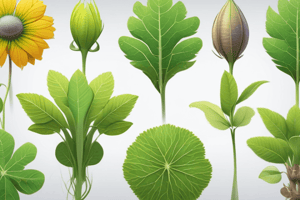Podcast
Questions and Answers
Which process involves the conversion of light energy into chemical energy?
Which process involves the conversion of light energy into chemical energy?
- Respiration
- Nutrient Uptake
- Transpiration
- Photosynthesis (correct)
What role do auxins play in plant physiology?
What role do auxins play in plant physiology?
- They promote cell elongation and root growth. (correct)
- They regulate fruit ripening and flower wilting.
- They stimulate seed germination and stem growth.
- They inhibit growth and stress responses.
Which of the following mechanisms helps regulate water loss in plants?
Which of the following mechanisms helps regulate water loss in plants?
- Gas Exchange
- Photosynthesis
- Osmosis
- Cuticle (correct)
What is the primary function of stomata in plants?
What is the primary function of stomata in plants?
Which nutrient class includes nitrogen (N), phosphorus (P), and potassium (K)?
Which nutrient class includes nitrogen (N), phosphorus (P), and potassium (K)?
Which type of growth do apical meristems primarily facilitate?
Which type of growth do apical meristems primarily facilitate?
Which adaptation is used by plants to minimize water loss during photosynthesis?
Which adaptation is used by plants to minimize water loss during photosynthesis?
What is turgor pressure critical for in plant cells?
What is turgor pressure critical for in plant cells?
How do cytokinins affect plant cells?
How do cytokinins affect plant cells?
What is the main function of mycorrhizal fungi in plant nutrition?
What is the main function of mycorrhizal fungi in plant nutrition?
Flashcards are hidden until you start studying
Study Notes
Plant Physiology
-
Definition: Study of the functions and processes of plants.
-
Key Processes:
-
Photosynthesis:
- Conversion of light energy into chemical energy.
- Occurs in chloroplasts using chlorophyll.
- Equation: 6CO₂ + 6H₂O + light energy → C₆H₁₂O₆ + 6O₂.
-
Respiration:
- Process of breaking down glucose to release energy.
- Formula: C₆H₁₂O₆ + 6O₂ → 6CO₂ + 6H₂O + energy (ATP).
-
Transpiration:
- Evaporation of water from plant surfaces, mainly leaves.
- Helps in nutrient transport and temperature regulation.
-
-
Growth and Development:
-
Meristems:
- Regions of actively dividing cells.
- Types: Apical (lengthening), Lateral (thickening).
-
Hormones:
- Auxins: Promote cell elongation and root growth.
- Gibberellins: Stimulate seed germination and stem growth.
- Cytokinins: Promote cell division and delay aging.
- Abscisic Acid: Inhibits growth, involved in stress responses.
- Ethylene: Regulates fruit ripening and flower wilting.
-
-
Nutrient Uptake:
- Essential Elements: Macronutrients (N, P, K) and Micronutrients (Fe, Mn, Zn).
- Soil Interaction: Roots absorb water and nutrients; mycorrhizal fungi enhance uptake.
-
Water Relations:
- Osmosis: Movement of water through a semipermeable membrane.
- Turgor Pressure: Pressure from water inside the cell, maintaining plant structure.
-
Gas Exchange:
- Stomata: Pores on leaves facilitating gas exchange (CO₂ in, O₂ out).
- Cuticle: Waxy layer minimizing water loss.
-
Adaptations:
- C4 and CAM Photosynthesis: Adaptations for water conservation and efficiency in arid conditions.
- Hydrophytes: Plants adapted to grow in water; have specialized structures for buoyancy and gas exchange.
-
Responses to Environment:
- Phototropism: Growth towards light.
- Gravitropism: Growth direction in response to gravity.
- Thigmotropism: Response to touch (e.g., climbing plants).
-
Plant Defense Mechanisms:
- Physical barriers (thorns, trichomes).
- Chemical defenses (secondary metabolites like alkaloids, tannins).
These concepts form the foundation of plant physiology, illustrating how plants interact with their environment, grow, and function at a cellular and systemic level.
Plant Physiology Overview
- Study of the functions and processes that govern plant life, including growth, metabolism, and responses to environmental stimuli.
Key Processes
-
Photosynthesis:
- Converts light energy into chemical energy within chloroplasts containing chlorophyll.
- Key equation: 6CO₂ + 6H₂O + light energy → C₆H₁₂O₆ + 6O₂.
-
Respiration:
- Involves breaking down glucose to release energy, primarily for cellular functions.
- Key equation: C₆H₁₂O₆ + 6O₂ → 6CO₂ + 6H₂O + energy (ATP).
-
Transpiration:
- The process of water evaporation from plant surfaces, especially leaves, crucial for nutrient transport and temperature control.
Growth and Development
-
Meristems:
- Areas of active cell division; responsible for plant growth.
- Two types: Apical meristems (lengthening) and Lateral meristems (thickening).
-
Hormones:
- Auxins: Promote cell elongation and root development.
- Gibberellins: Stimulate seed germination and elongation of stems.
- Cytokinins: Encourage cell division and delay senescence (aging).
- Abscisic Acid: Inhibits growth; plays a role in stress response.
- Ethylene: Influences fruit ripening and flower wilting.
Nutrient Uptake
-
Essential Elements:
- Macronutrients include Nitrogen (N), Phosphorus (P), and Potassium (K); Micronutrients involve Iron (Fe), Manganese (Mn), and Zinc (Zn).
-
Soil Interaction:
- Roots are responsible for water and nutrient absorption; mycorrhizal fungi can improve nutrient uptake efficiency.
Water Relations
-
Osmosis:
- The process of water movement through a semipermeable membrane, critical for maintaining hydration in plants.
-
Turgor Pressure:
- Internal pressure from water in plant cells, which supports plant structure and rigidity.
Gas Exchange
-
Stomata:
- Small pores on leaf surfaces that regulate the exchange of CO₂ (intake) and O₂ (release).
-
Cuticle:
- A waxy layer on leaves that reduces water loss, protecting against desiccation.
Adaptations
-
C4 and CAM Photosynthesis:
- Specialized methods in plants for maximizing water conservation and photosynthetic efficiency, particularly in arid regions.
-
Hydrophytes:
- Aquatic plants with adaptations like buoyant structures and specialized gas exchange systems.
Responses to Environment
-
Phototropism:
- Growth response of plants towards light, optimizing photosynthesis.
-
Gravitropism:
- Directional growth based on gravity, helping roots grow downwards and shoots upwards.
-
Thigmotropism:
- Growth in response to touch, notably seen in climbing plants.
Plant Defense Mechanisms
-
Physical Barriers:
- Structures like thorns and trichomes deter herbivores and provide protection.
-
Chemical Defenses:
- Production of secondary metabolites (e.g., alkaloids and tannins) to repel pests and pathogens.
Studying That Suits You
Use AI to generate personalized quizzes and flashcards to suit your learning preferences.




